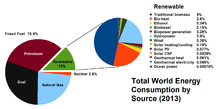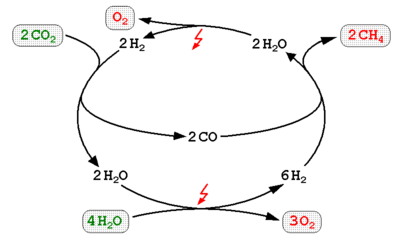enewable energy is generally defined as energy that is collected from resources which are naturally replenished on a human timescale, such as sunlight, wind, rain, tides, waves, and geothermal heat. Based on REN21‘s 2016 report, renewables contributed 19.2% to humans’ global energy consumption and 23.7% to their generation of electricity in 2014 and 2015.
Efficient energy storage is very important with many renewable power sources, because the energy generated by them changes a lot depending on day time and weather (especially wind and solar power). Electrical energy is stored during times when production (especially from intermittent power plants such as renewable electricity sources such as wind power, tidal power, solar power) exceeds consumption, and returned to the grid when production falls below consumption.
Efficient energy storage is challenge. Battery powered energy storage systems have been designed and built (for example Tesla Energy), but they have challenges especially on the cost, making it hard to justify the costs of them in wide scale use (there are special applications where they are excellent already).
A new and interesting way to store energy is Power to gas. Power to gas (often abbreviated P2G) is a technology that converts electrical power to a gas fuel.[1] There are currently three methods in use; all use electricity to split water into hydrogen and oxygen by means of electrolysis. It is possible to combine the hydrogen with carbon dioxide and convert the two gases to methane that may then be fed into the natural gas grid.
Methane can be used for heating, for running cars and can be quite easily stored. Burning this way methane will release CO2 the same amount that was used when generating that synthetic methane – it is carbon neutral over the usage cycle.
In 2013 a power-to-gas research project has been launched in Germany. A research network of institutes and companies will evaluate the capability of long-term storage technologies in a 100% renewable energy electricity scenario. Eleven European companies have established the North Sea Power to Gas Platform, a joint body to explore the viability of power-to-gas in the countries surrounding the North Sea area. The combined generating capacity of offshore wind farms on the North Sea could reach about 100 GW by 2030, while the PV capacity installed in the countries surrounding the North Sea is expected to increase from 35 GW in 2012 to almost 60 GW in 2020. P2G is expected to play an increasingly vital role in the way energy systems develop as the issue with renewable energy sources like solar and wind power is intermittency. With the P2G concept, temporal surpluses can be reduced by converting renewable energy into gas.
The development of P2G is continuing. Audi opens 6 MW power-to-gas facility article tells that Audi has opened in 2013 a 6 MW power-to-gas facility in Germany, making it the first automaker to develop a chain of sustainable energy carriers. The plant, located in the Lower Saxony city of Wertle, uses green electricity, water and carbon dioxide to create hydrogen and a synthetic methane known as Audi e-gas that is distributed to compressed natural gas (CNG) filling stations. The project shows that large amounts of green electricity can be stored efficiently and independently of location by transforming it into methane gas and storing it in the natural gas network, the largest public energy storage system in Germany.
P2G will also be tested in Finland. Lappeenranta University of Technology and VTT Technical Research Centre of cooperation will be built a demo plant, which will be piloted in the production of gas with solar power systems. The raw material used in the sun, water and carbon dioxide separated from the air. The study is the first of its kind for this type of integration of processes in Finland. Research will seek to build know-how, which allow the implementation of industrial-scale solutions. second main purpose of the project is to create new business opportunities for Finnish industry.
This power to gas looks link a very interesting technology to solve energy storage challenges that you get with wide use of intermittent clean renewable energy.



3 Comments
Tomi Engdahl says:
Researchers Convert Biomass To Hydrogen Using Sunlight
https://hardware.slashdot.org/story/17/03/15/017220/researchers-convert-biomass-to-hydrogen-using-sunlight?utm_source=feedburner&utm_medium=feed&utm_campaign=Feed%3A+Slashdot%2Fslashdot%2Fto+%28%28Title%29Slashdot+%28rdf%29%29
Cambridge chemists have developed a new catalytic approach capable of converting biomass into hydrogen gas using only sunlight as an energy source. The method converts lignocellulose, one of Earth’s most abundant biomaterials, into hydrogen gas and organic byproducts when in a basic water and in the presence of the cadmium sulfide/oxide nanoparticle catalysts.
Solar Power Harnessed to Generate Hydrogen
http://www.rdmag.com/article/2017/03/solar-power-harnessed-generate-hydrogen
A team of scientists have found a way to use solar power to generate a sustainable and relatively cheap fuel by using natural light to generate hydrogen from biomass.
“Lignocellulose is nature’s equivalent to armored concrete,” Kuehnel said in a statement. “It consists of strong, highly crystalline cellulose fibers, that are interwoven with lignin and hemicellulose which act as a glue. This rigid structure has evolved to give plants and trees mechanical stability and protect them from degradation and makes chemical utilization of lignocellulose so challenging.”
The hydrogen produced is free of fuel-cell inhibitors, such as carbon monoxide, which allows it to be used for power.
The research team used different types of biomass in their experiments including pieces of wood, paper and leaves that were placed in test tubes and exposed to solar light.
“Our sunlight-powered technology is exciting as it enables the production of clean hydrogen from unprocessed biomass under ambient conditions,”
Tomi Engdahl says:
The pilot plant produces fuel from carbon dioxide
Technology Research Center The unique Soletair pilot plant of VTT and Lappeenranta University of Technology uses carbon dioxide to produce renewable fuels and chemicals. The pilot plant is connected to the LUT solar power plant in Lappeenranta.
The aim of the project is to prove the technical operation of the overall process and to produce 200 liters of fuels and other hydrocarbons for research use. It is the only experimental plant in its kind, where the entire chain of processes from the production of solar power to the production of hydrocarbons takes place in one place.
The units in the pilot class unit are designed for decentralized, small production. Production capacity can be increased by increasing the number of units.
“The concept we are examining is an example of how the chemical industry can be electrified in the future. Fossil fuel burning must end by 2050, but the need for human hydrocarbons is not completely lost, “says Professor Jero Ahola of LUT.
VTT and LUT have invested over € 1 million in equipment. Research is funded by Tekes and a number of companie
Source: http://www.etn.fi/index.php/13-news/6451-pilottilaitos-tuottaa-polttoainetta-hiilidioksidista
Tomi Engdahl says:
Nano blast: solar energy directly as hydrogen fuel
For the storage of solar energy, hydrogen has been a real breakthrough in Central Florida University. With the help of the new nanomaterials, hydrogen can be isolated more and more efficiently from seawater.
Because the invention was made just in Florida, there is also a local economic dimension: there is silence both sunlight and sea water. The first commercial applications of the material may well come into use near its development site. This is also the objective of the research group that has developed it.
Associate Professor Yang Yang has worked harder to separate hydrogen from solar water for almost ten years. Separation is then required by a photocatalyst, a substance that accelerates the energy from light by using a chemical hydrogen separation reaction.
The newly-developed photocatalyst not only lasts for good sea water but is also able to utilize the sunlight energy in a much wider wavelength range than most photocatalytes. The trick was made by building a new kind of hybrid material on the bottom of the most widely used photocatalyst, titanium dioxide.
The material is based on an extremely thin titanium dioxide film, which scientists made chemically nano-sized openings. Small nano openings were coated in the next step with molybdenum disulphide flakes, two-dimensional material that is only one layer of atomic layer.
One good part of the storage of solar energy directly as hydrogen fuel compared to electricity produced by solar panels is to avoid the use of batteries as energy storage. Battery packs are used when charging and unloading the battery, which limits battery life. Instead, the energy that is captured remains in a storage that is stored and movable for a long time.
Source: http://www.tivi.fi/Kaikki_uutiset/nanolapimurto-aurinkoenergiaa-suoraan-vetypolttoaineeksi-6681069
More:
MoS2/TiO2 Heterostructures as Nonmetal Plasmonic Photocatalysts for Highly Efficient Hydrogen Evolution
http://pubs.rsc.org/en/Content/ArticleLanding/2017/EE/C7EE02464A?_escaped_fragment_=divAbstract#!divAbstract